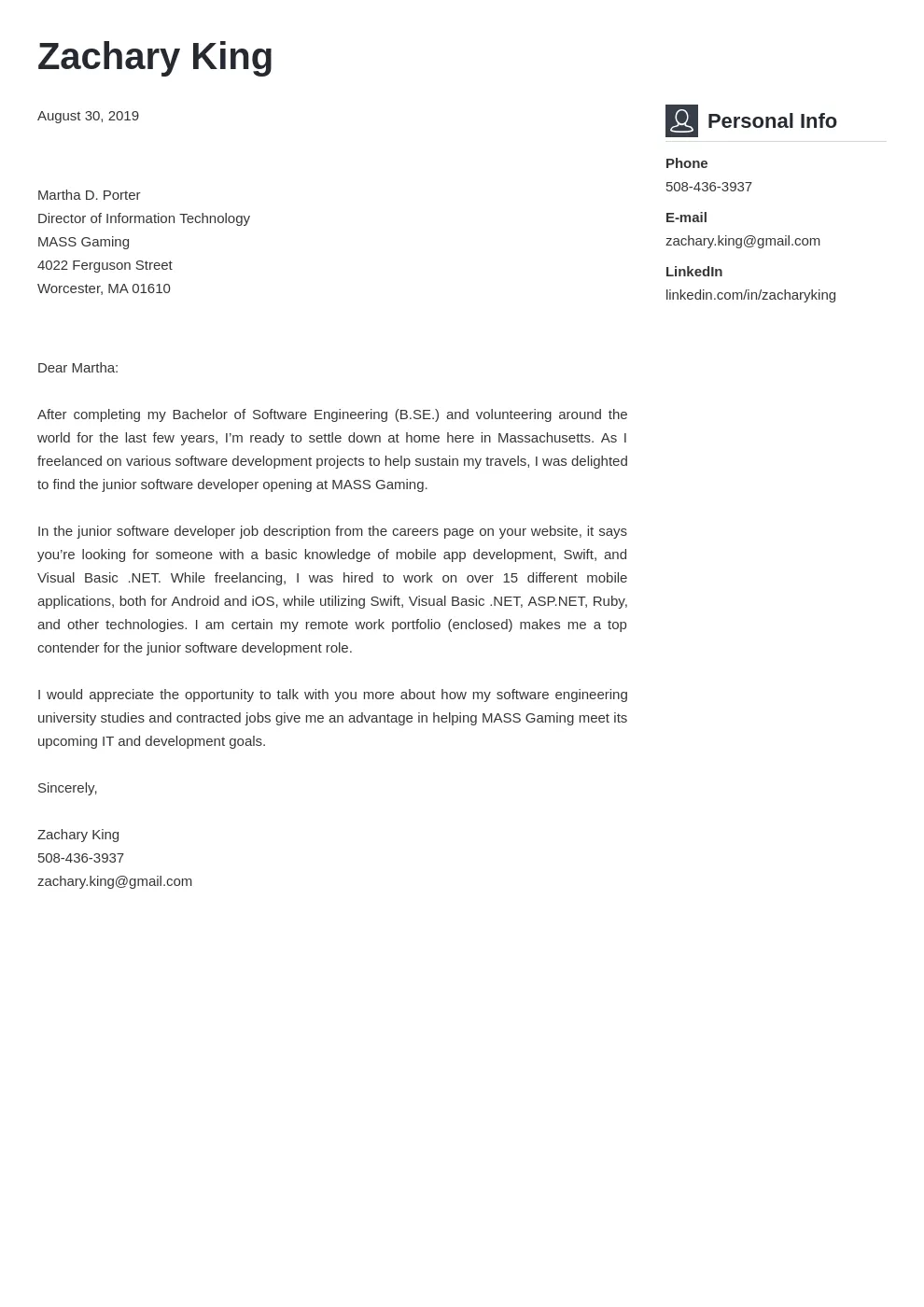Why a Cover Letter Matters for Software Engineers
In the competitive field of software engineering, a cover letter is more than just an optional document it’s your first chance to make a strong impression. While your resume provides a snapshot of your skills and experience, your cover letter allows you to tell a story, to demonstrate your personality, and to explain why you are the perfect fit for the specific role and company. It’s an opportunity to connect with the hiring manager on a personal level, showing them your passion for software engineering and your understanding of their needs. This document can highlight your unique value proposition and set you apart from other applicants. In a world where technical skills are often assumed, your cover letter gives you the edge by showcasing your communication skills and your ability to think critically about the job at hand. Think of it as your personal introduction, carefully crafted to generate interest and secure you an interview.
Highlighting Your Skills
Your cover letter is your platform to showcase your relevant skills to the role you are targeting. This section should be tailored to the job description, highlighting the specific technical and soft skills the employer is seeking. Don’t just list your skills; demonstrate them through concrete examples from your past experiences. This will help the recruiter to understand the value you bring. For a Software Engineer, this is especially important because the industry is constantly evolving. You need to demonstrate that you have not only mastered core technologies but also have a passion for learning and staying current with emerging trends. Highlighting your skills strategically increases the likelihood of the recruiter reviewing your application with interest.
Technical Skills Showcase
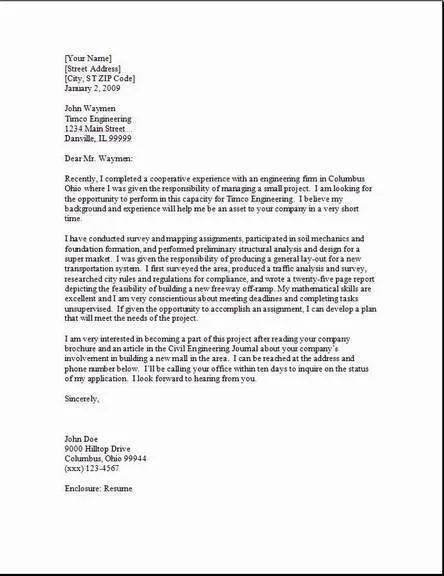
When discussing technical skills, be specific. Instead of saying you ‘know programming languages’, list the specific languages you are proficient in, such as Java, Python, C++, or JavaScript. Mention any frameworks or libraries you’re experienced with, like React, Angular, or Django. Provide examples of how you’ve used these skills to solve problems or build projects. For instance, you could mention how you developed a specific feature using a particular language, highlighting the technologies used, and the challenges you overcame. If you’ve contributed to open-source projects or have a portfolio, be sure to mention them. Demonstrating a deep understanding and practical application of technical skills is critical in convincing employers of your capabilities. Moreover, mention any specializations, like data science, cloud computing, or cybersecurity, and align them with the job requirements.
Soft Skills Demonstration
Soft skills are just as important as technical skills for a software engineer. Your cover letter should showcase your ability to work in a team, communicate effectively, and solve problems. Mention any experience you have working collaboratively on projects, highlighting your role and contributions. Use examples to illustrate your communication skills, such as presenting complex technical concepts to non-technical stakeholders or writing clear and concise documentation. Showcase your problem-solving abilities by describing a time you overcame a difficult technical challenge or implemented an innovative solution. Skills like adaptability, critical thinking, and time management should also be highlighted. Tailor your discussion of these skills to the job description, focusing on the ones the employer emphasizes. By showcasing your soft skills, you demonstrate that you’re not just a skilled coder but also a valuable team player.
Quantifying Achievements
One of the most effective ways to make your cover letter stand out is to quantify your achievements. Instead of saying you ‘improved efficiency,’ state the percentage increase or the time saved. Use numbers to demonstrate the impact of your work. This data adds credibility and helps the employer understand the concrete value you bring to the table. When describing your accomplishments, always try to include specific metrics. This approach not only validates your claims but also showcases your ability to measure success. Including quantifiable results will make your achievements more convincing. It’s a powerful way to tell the recruiter that your work translates to measurable benefits for the company. Providing the context of how your achievements were attained is also a great idea, which adds to the impact of your work.
Using Numbers and Data
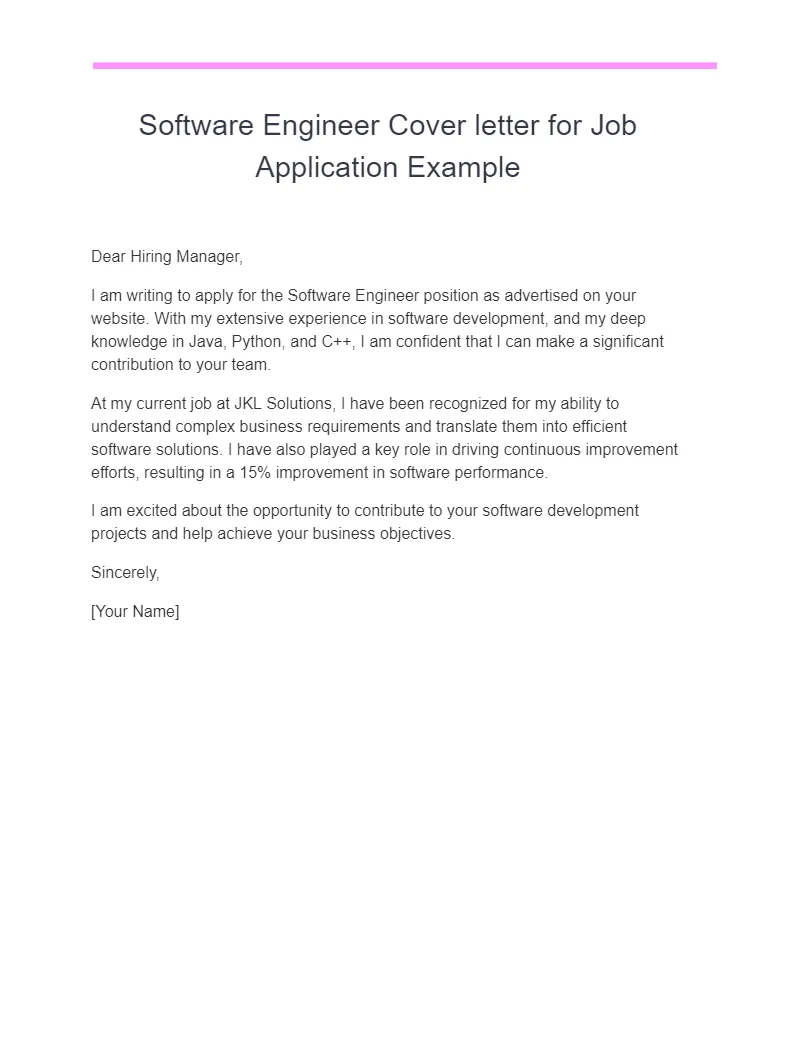
Use data and numbers to illustrate your achievements. Instead of saying you ‘improved website performance,’ say that you ‘reduced page load times by 30%’. If you optimized code, mention the percentage reduction in processing time or memory usage. When discussing a project, include the number of users, the growth rate, or the amount of revenue generated. For example, if you developed a mobile app, mention the number of downloads or the user retention rate. Include data about how you optimized code or increased efficiency to illustrate your expertise. Any numbers you use should be relevant and accurately reflect your contributions. Quantifiable results create a strong impression and enable employers to understand the direct impact of your work.
Showcasing Projects
Your cover letter is an opportunity to highlight your most significant projects. When discussing projects, provide a brief overview of the project’s purpose, your role, and the technologies you used. Then, emphasize the results. This is where you should include the data and numbers that quantify your achievements. Include a link to the project on your portfolio, GitHub, or other relevant platforms. Consider detailing the specific challenges you faced and how you overcame them. This demonstrates your problem-solving skills and your ability to learn from experience. When mentioning projects, be sure to choose those that align with the job description and the company’s goals. This strategy allows you to demonstrate your ability to create tangible results.
Tailoring Your Letter
A generic cover letter will not impress a hiring manager. You should always tailor your cover letter to the specific job and company. This shows that you’ve invested the time to understand their needs and that you’re genuinely interested in the opportunity. Your letter should reflect your understanding of the company’s mission, values, and culture. This approach shows that you’re not just sending out mass applications, but that you’re strategically targeting the specific role. It’s also a way to show that you’ve done your homework and understand what the company is looking for. A tailored approach increases your chances of getting noticed and landing an interview.
Researching the Company

Before you begin writing, research the company thoroughly. Visit their website, read their ‘About Us’ section, and check their social media profiles. Understand their products, services, and target market. Look for information about their culture and values. See if you can find out about recent projects or announcements. If possible, research the hiring manager or the team you’d be working with. This information will help you tailor your cover letter to the specific needs of the company. Mentioning specific projects, values, or goals of the company demonstrates your interest and shows that you’re aligned with their mission. The more you know, the better you can align your skills and experience with their requirements.
Matching Skills to Requirements
Carefully review the job description and identify the key requirements. Then, in your cover letter, explicitly state how your skills and experience align with those requirements. Use keywords from the job description throughout your letter. Give specific examples to show how you’ve used those skills in the past. Highlight any relevant experience or projects that demonstrate your ability to meet the company’s needs. When matching your skills, make sure to be authentic. Don’t exaggerate or claim skills you don’t possess. Be honest about your experience and focus on the skills that you do have. The goal is to convince the employer that you’re a good fit for the job.
Formatting and Structure
The structure and formatting of your cover letter are just as important as the content. A well-formatted letter is easy to read and demonstrates your attention to detail. Use a professional font, such as Arial, Times New Roman, or Calibri, with a font size of 10-12 points. Ensure the letter has consistent spacing and alignment. Break up the text with paragraphs and bullet points to make it more readable. Keep your cover letter concise, ideally no more than one page. The format is essential in creating a positive first impression. Also, review and make adjustments to formatting, so that it’s easy to read. It will showcase your professionalism and attention to detail.
Professional Tone and Language
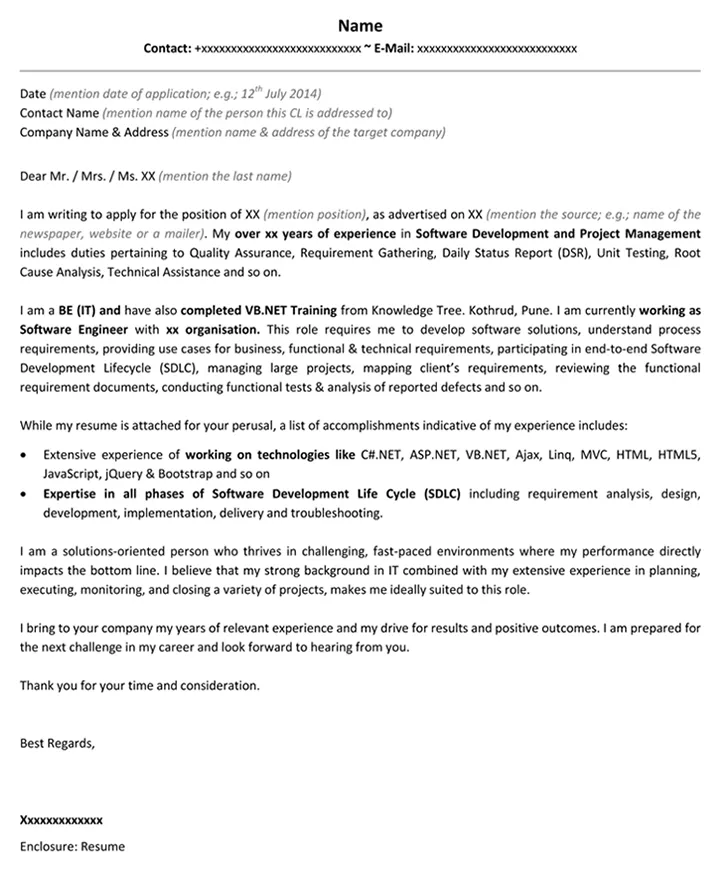
Maintain a professional tone throughout your cover letter. Use clear, concise language and avoid jargon or slang. Proofread your letter carefully for any grammatical errors or typos. Your goal is to present yourself as a serious and competent professional. The language you use should reflect the company culture. If the company is formal, use a more formal tone. If it’s more casual, you can adjust your tone accordingly. Avoid using overly flowery language or clichés. Aim for direct, engaging language that conveys your message clearly and concisely. Moreover, make sure your language is inclusive and respectful. This will help you create a strong first impression.
Concise and Engaging Writing
Hiring managers often have a lot of cover letters to read, so it is essential to keep yours concise and engaging. Start with a strong opening that grabs the reader’s attention. Keep paragraphs short and to the point. Use action verbs to describe your accomplishments. Break up the text with bullet points. Avoid unnecessary repetition or fluff. Each sentence should have a purpose. Your goal is to tell your story clearly and efficiently. The more engaging your letter is, the more likely it is that the hiring manager will read it to the end. Also, consider the use of bullet points to highlight key skills and achievements, this method ensures that your most impactful points are easily visible.
Call to Action and Closing
Your cover letter should conclude with a clear call to action. Let the employer know that you’re interested in an interview and eager to discuss your qualifications further. Reiterate your enthusiasm for the position and the company. Thank the hiring manager for their time and consideration. In your closing, you should reiterate your interest. This includes showing the desire to schedule an interview and emphasize the value you bring to the team. Moreover, a well-crafted closing statement will leave a positive and lasting impression.
Expressing Enthusiasm
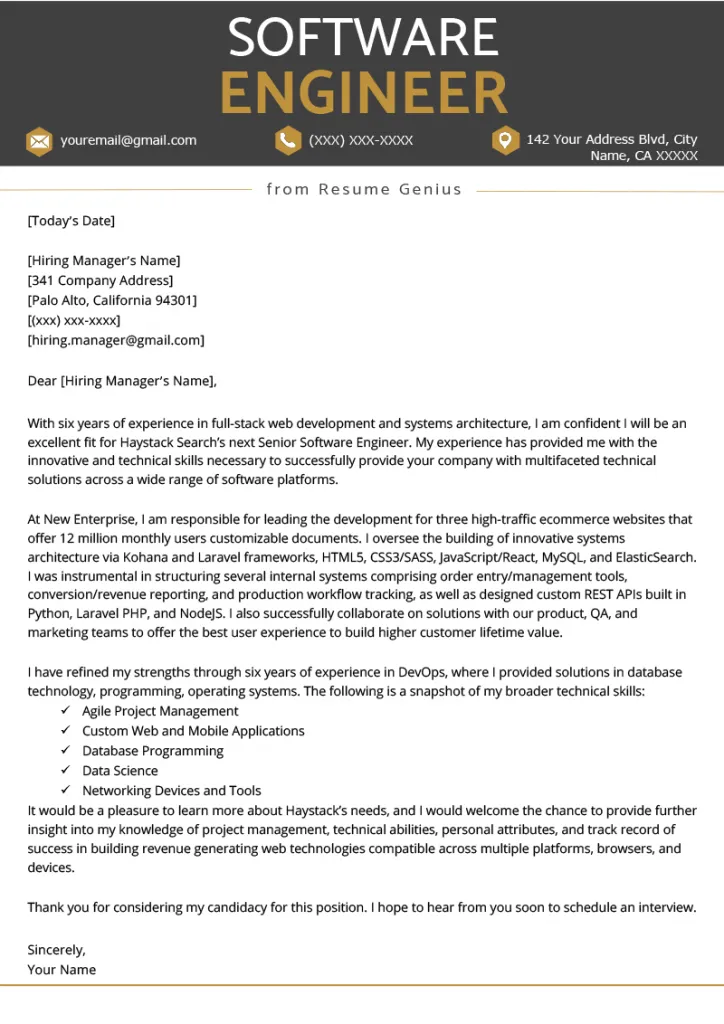
Express your enthusiasm for the position and the company. Show the hiring manager that you’re excited about the opportunity and that you’re genuinely interested in working for them. Mention specific reasons why you are drawn to the role and the company. This could be the company’s mission, culture, or the projects they’re working on. Expressing enthusiasm also involves mentioning your eagerness to learn and contribute to the team. This will help you stand out from other applicants. Moreover, let your personality shine through, but keep it professional. This will help you demonstrate your passion and your eagerness to take the next step.
Providing Contact Information
Make sure to include your contact information in your cover letter, including your phone number, email address, and LinkedIn profile URL. This will make it easy for the hiring manager to contact you. Ensure that your contact information is accurate and up-to-date. Be sure to follow up with a thank-you email after the interview. It can be useful to add a link to your online portfolio or personal website. By providing your contact information, you make the recruitment process easier. Double-check your details to avoid any errors. The best way to make a good impression on recruiters is to provide accurate and accessible information.
